Our 2020 Jeep Gladiator Mojave Came Up Short

30,000-Mile Update
In the wake of the Jeep Gladiator's 10Best win for its debut model year, our hopes were high as we welcomed a 2020 Mojave model into our long-term fleet. Despite not being our top pick for pure pickup duty, as a third-place finish in a comparison test proved, the Gladiator was (and still is) a bolt of freshness in the mid-size truck segment, a novel workhorse with rugged presence, a convertible top, and a solid-axle Jeep lineage. Unfortunately, our initial excitement began to fade as mechanical issues and day-to-day frustrations beset our Jeep pickup. The Gladiator would eventually leave us before it could complete its 40,000-mile test, having bumped up against Stellantis's 12-month loan agreement limit. But we weren't terribly sad to see it go.
We bear some of the brunt for our test truck's disappointment. Choosing the Mojave's six-speed manual transmission instead of its optional $2000 eight-speed automatic did the standard 285-hp 3.6-liter V-6 no favors. With fewer gear ratios and the engine's 260 pound-feet of torque arriving at a high 4400 rpm, we had to really work our truck's clunky shifter and clutch pedal to generate meaningful speed. That was fun at first but eventually grew tiring. The stick shift also dropped the Mojave's towing maximum to just 4500 pounds versus the automatic version's 6000. Our truck's sleepy 8.5-second run to 60 mph made it slow, significant amounts of road and wind noise inside the cabin (71 decibels at 70 mph) made it taxing to pilot, and a dismal 15-mpg result on our 75-mph highway test and a 16-mpg average overall made it woefully inefficient.

The Gladiator's optional 260-hp 3.0-liter V-6 turbo diesel may have been a better fit for us, but it's not available on the Mojave trim. After 30,000 miles, we're convinced that the eight-speed auto is the way to go in any Gladiator, frustrating as that may be for savers of manuals and the Jeep faithful's most devout members. What's more, troubles with our truck's transmission ultimately resulted in its full replacement under warranty at 8424 miles, a fix that took it out of service for a whopping 29 days.
The Mojave trim level is the only Jeep so far to wear the brand's Desert Rated badge, which denotes a greater proficiency in higher-speed off-road conditions, but it also left us wanting. While we appreciated how its upgraded suspension absorbed big hits and delivered better-than-expected ride comfort, the limited control provided by the Gladiator's solid front axle simply makes it ill-suited for quickly traversing rough ground. There's a reason desert racers abandoned that setup decades ago in favor of independent front suspensions.

We knew the Gladiator's recirculating-ball steering would require frequent attention at highway speeds. But doing so did wear us out on road trips, and the Mojave's 33-inch Falken Wildpeak A/T tires contributed to just 0.72 g of skidpad grip and a long 197-foot stop from 70 mph. In hindsight, a smarter pick for a highly capable Jeep with a pickup bed would be the similarly priced Rubicon trim, which drives about the same yet brings an electronically locking front differential and disconnecting front anti-roll bar—features that bolster the Gladiator's capability in more traditional off-roading yet are not available on the specialized Mojave.
Which leads us to the latest chapter in our troublesome long-termer's saga: the replacement of its rear axle assembly under warranty at 24,491 miles. Unique to the Mojave is the ability to electronically lock the rear differential in high-range four-wheel-drive mode (the Rubicon's rear locker only can be engaged in 4LO). This feature was added for 2021, so 2020 model-year examples like ours were retrofitted with a dealer-installed software update. But while we were waiting for that to happen, the operation of our truck's rear locker was hampered by an electrical issue that was traced to a faulty locking actuator buried deep in the rear axle, necessitating the replacement of the full assembly and an additional nine days out of service.
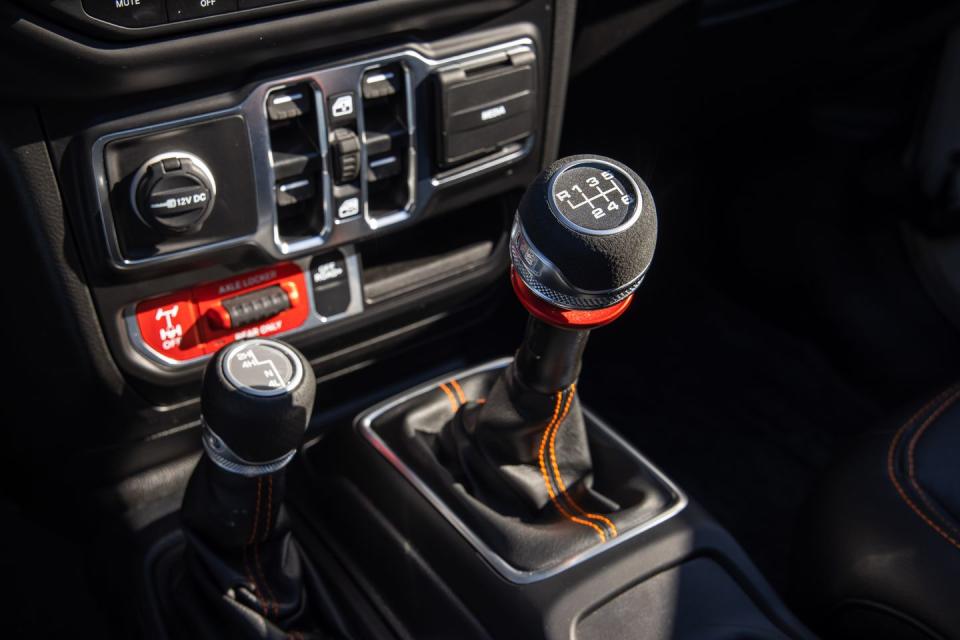
Fortunately, the axle fix didn't cost us anything. We did spend $66 for our third oil-and-filter change at 27,308 miles, and a scheduled 30K-mile service (inspection, new engine air filter, transmission service, and transfer-case fluid change) cost us $286, bringing our regular service total to $622. Factor in the previous $276 replacement of a damaged right-rear tire and our Jeep's out-of-pocket expenses tallied just under $900.
The Gladiator's strength lies in its entertainment value as an occasional-use vehicle. No matter where we took ours—its final adventure being a trek from Ann Arbor to Alabama and back—it stood out with its imposing presence. Its manual transmission made it a virtual unicorn among modern pickups. And the Mojave model, despite its drawbacks, remains arguably the most comfortable-riding solid-axle Jeep available. Additional fun could be had by removing its doors and the hardtop's roof panels (or taking the top off altogether).
But for every positive trait that our Gladiator exhibited, there was at least one shortcoming that hurt both its capability and appeal—even as a novelty. While a different model configuration might have produced a more favorable consensus among our staff, the Gladiator is still saddled with a tiny pickup bed, uncomfortable ergonomics, and poor on-road manners compared to other mid-size pickups. And there's simply no getting around the two major mechanical problems we experienced with our rig, which stickered for $58,920 as tested. The final comment in our long-termer's logbook ably sums up our feelings: "The Mojave's cool factor just can't make up for its compromises."
Months in Fleet: 14 months Current Mileage: 30,212 miles
Average Fuel Economy: 16 mpg
Fuel Tank Size: 22.0 gal Observed Fuel Range: 350 miles
Service: $622 Normal Wear: $0 Repair: $0
Damage and Destruction: $276
20,000-Mile Update

Staff editor Drew Dorian summed up our initial take on the Jeep Gladiator with a recent gem in our long-termer's logbook: "I can't think of another vehicle on sale today that is as flawed but still utterly charming. Everything about the way this truck drives is clunky, awkward, and uncomfortable—and yet I loved every minute behind the wheel." For an old-school pickup with two solid axles and the added novelty of a convertible top, that's a high compliment. But as our Gladiator Mojave rolls (slowly, noisily) past the halfway point of its 40,000-mile test, praise for its eccentric character has become less common as its day-to-day frustrations grow more prominent.
By now, our gripes about the Gladiator are familiar: It's loud inside, plodding on the move, and its steering seems to have only a casual relationship with the front wheels. "It looks badass, but I wouldn't want to commute in something with so little sound deadening and tires this noisy," read a logbook comment that went on to point out how the truck's upright dashboard forces even diminutive drivers to grasp the wheel with scrunched-up arms.
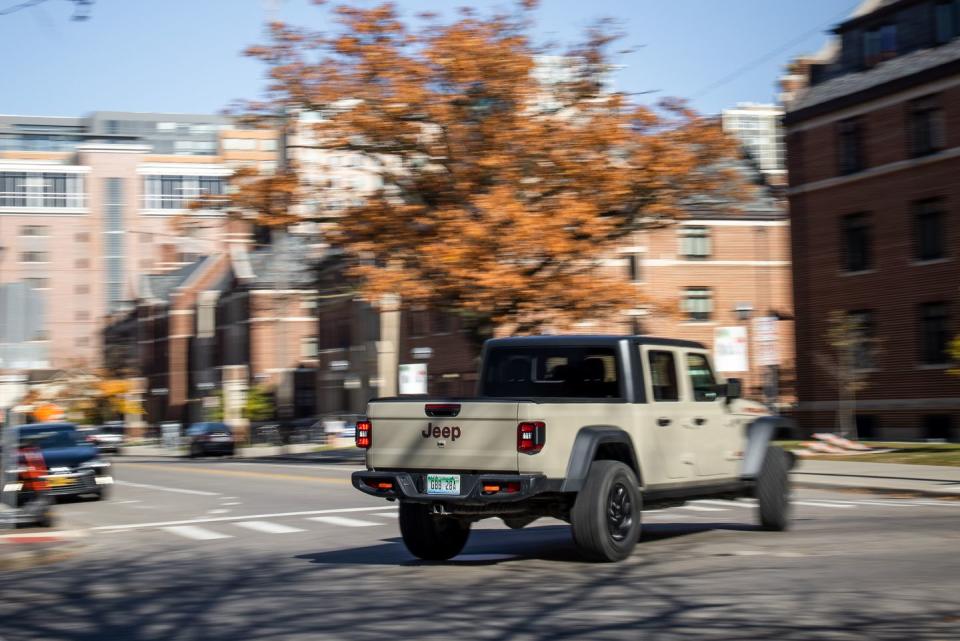
Long-distance travel remains a chore in Jeep's mid-size pickup. Yet our rig has stayed relatively active within Michigan's borders, including a trip to the west side of the state for an outing on the Silver Lake Sand Dunes, plus a camping excursion to the Upper Peninsula. Some takeaways from those adventures are as follows: Our truck's soft tonneau cover is not secure enough to prevent hungry raccoons from loosening its fasteners and climbing inside the bed in search of foodstuffs that we thought were safely stowed away. And the high-strung 3.6-liter V-6, with its 4400-rpm torque peak, is not ideally suited for traversing deep sand. Even with a decent 285 horsepower on tap, we often had to engage the four-wheel-drive system's low range and abuse the six-speed manual's clutch to make any meaningful progress in the dunes. No thanks to the dunes, our average fuel economy is up 1 mpg, now to 16 mpg.
While we'd like to visit Silver Lake again to better evaluate the Mojave trim's Desert Rated suspension, our excitement—and our long-termer's sturdiness—is beginning to wane. Its manual parking-brake handle has developed an annoying rattle and the manual shifter has the exactitude of a stick stirring a bucket of rocks. "This thing starts with a clatter that makes me worry about its long-term durability," wrote director of vehicle testing Dave VanderWerp.
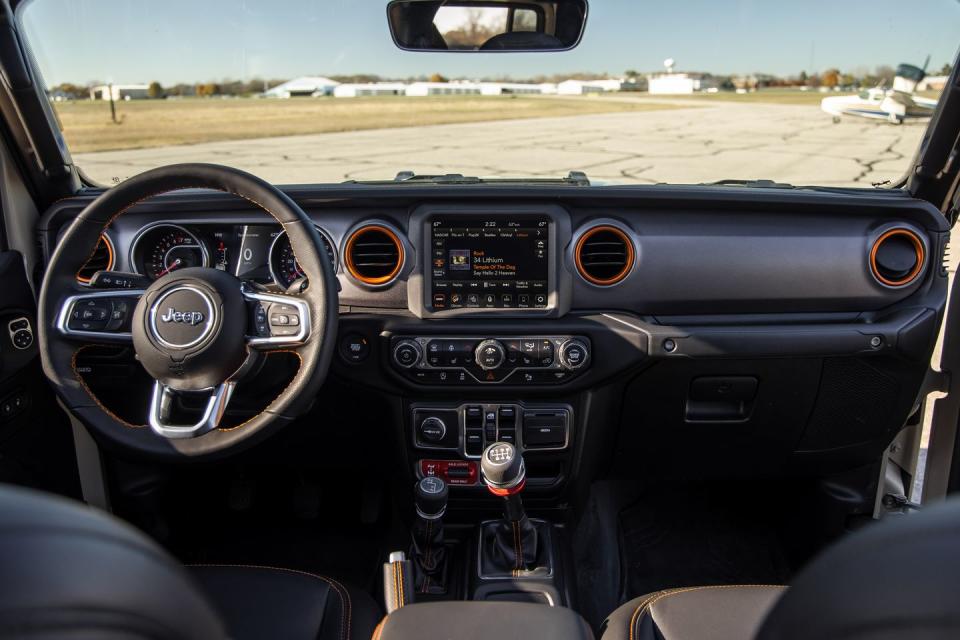
Sadly, we've been unable to rectify some issues with our truck's electronically locking rear differential. As a refresher, the rear diffs in 2021 model-year Mojave models can be locked in high-range four-wheel drive to improve off-road traction at higher speeds, but initial 2020 models such as ours lack that ability. Jeep has released a software update that is supposed to bring those early trucks up to spec. However, our long-termer also has gained an electronic glitch that falsely indicates the locker is engaged when it is not—and from what we can tell it cannot be locked at all. Pandemic-related issues have complicated leaving our truck at the dealer for the necessary amount of time for a full diagnosis, but we'll follow up soon with an update.
Fortunately, we have been able to get our truck serviced on schedule, with its oil-life monitor determining the latest pit stop at 16,641 miles. That included an oil change, tire rotation, and a cabin air filter replacement, all of which amounted to a $176 bill. Replacing a flat Falken WildPeak A/T3W tire cost us another $276.

Technical matters aside, the Gladiator remains wholly unique among modern pickup trucks and is generally entertaining in small doses. But our example has thus far been rather problematic and not entirely enjoyable to live with, diminishing its appeal. Another commenter wrote, "I love how mission-driven the Gladiator is, but what exactly is that mission—look cool, feel miserable?" We have a little over 16,000 miles left to come up with a better answer.
Months in Fleet: 12 months Current Mileage: 23,788 miles
Average Fuel Economy: 16 mpg
Fuel Tank Size: 22.0 gal Observed Fuel Range: 350 miles
Service: $270 Normal Wear: $0 Repair: $0
Damage and Destruction: $276
10,000-Mile Update
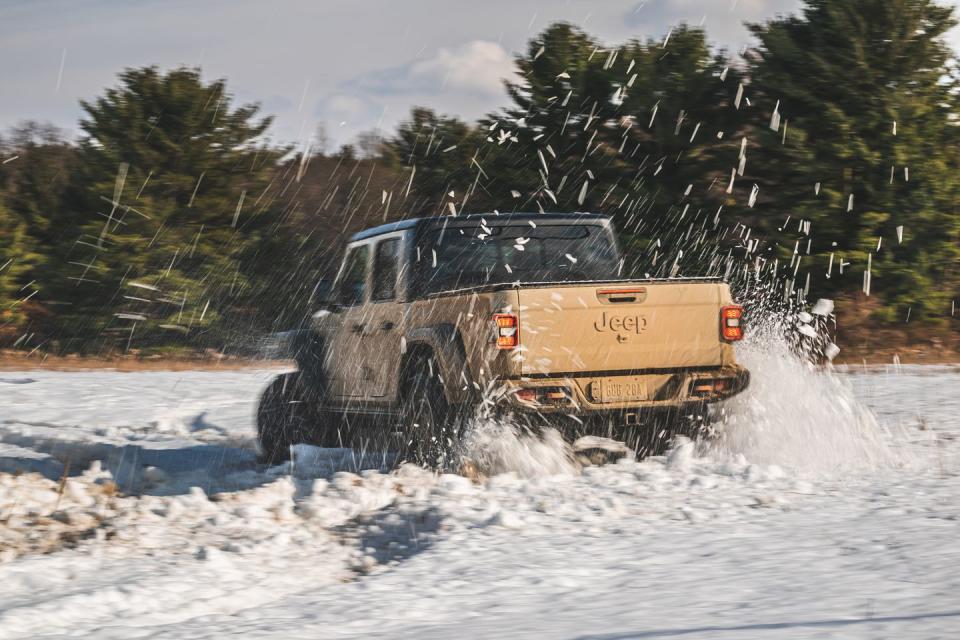
There is little disagreement among our staff that our Jeep Gladiator Mojave is cool, what with its rugged swagger, removable top and doors, manual transmission, and impressive off-road credentials. "Is it $58K cool?" opined technical editor David Beard in the Gladiator's logbook. "No, not even close." That declaration may be a little premature considering our truck has only just crossed the quarter-way point of its 40,000-mile test, but it does illustrate that things have not gone as swimmingly as we had hoped for Jeep's 10Best-winning compact pickup.
Cool or not, our Gladiator has already earned a big demerit for spending a combined 29 days out of service to have its transmission replaced under warranty. Less than 1000 miles after its first scheduled service visit at 7600 miles—a $94 job consisting of an oil change, tire rotation, and various inspections—we returned to have the dealer diagnose a rattling from its clutch and a whining noise from the gearbox itself, particularly when in lower gears. Per a recent recall for certain manual-transmission Wranglers and Gladiators, Jeep HQ advised the dealer to replace the six-speed and inspect the clutch assembly. That inspection revealed multiple overheated sections on the clutch's pressure plate and excessive play in the dual-mass flywheel, both of which necessitated the replacement of the full assembly.
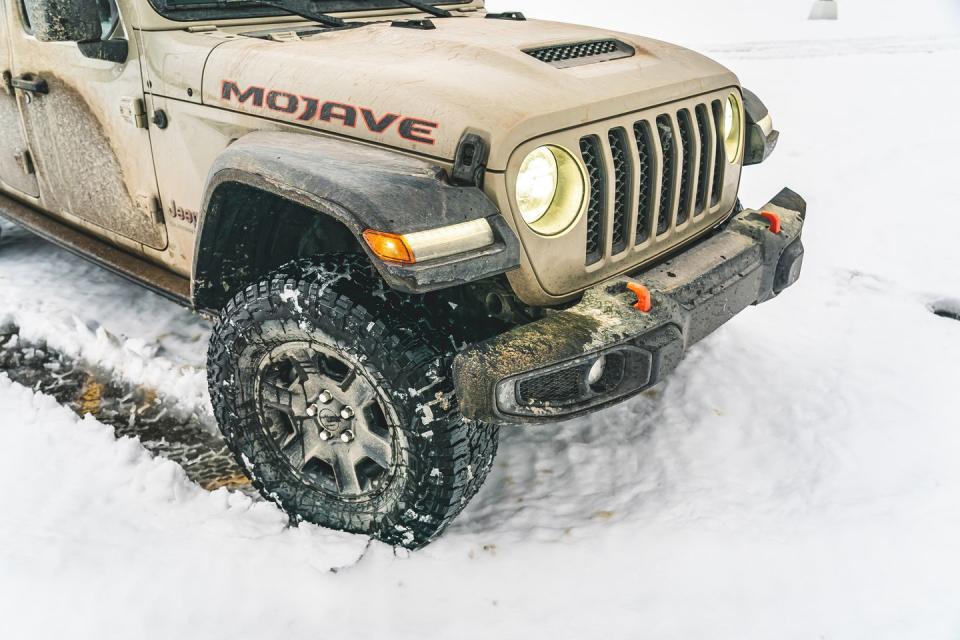
Thankfully, nothing failed catastrophically and caused a fire, which was the main concern of the recall. But the dealer did not yet have the tools needed to disassemble the transmission, so an investigative tear down could not be performed. Nor has the dealer yet received Jeep's latest software update, which addresses the recall issue by supposedly limiting the engine's torque if the clutch gets too hot again. We'll have that update installed as soon as it's available, but our Mojave's new drivetrain appears to be operating as it should for now.
The Gladiator's regular operation comes with its own share of issues, though. As we assumed when we configured our long-termer, its composition does not make it the best daily commuter or long-range highway traveler. For one, the Mojave is painfully slow, thanks in part to the peaky nature of its 3.6-liter gas V-6, which has to be thrashed to around 4000 rpm before it makes any meaningful grunt. Having to operate the clunky six-speed shifter and clutch pedal doesn't help matters, even though the entertaining novelty of a stick shift does suit a solid-axle Jeep's character. As some of us adapt to our truck's plodding nature better than others, logbook musings have questioned whether the Gladiator's available diesel V-6—which sadly both isn't offered on the Mojave trim and requires the optional eight-speed automatic—might have been a more livable setup.
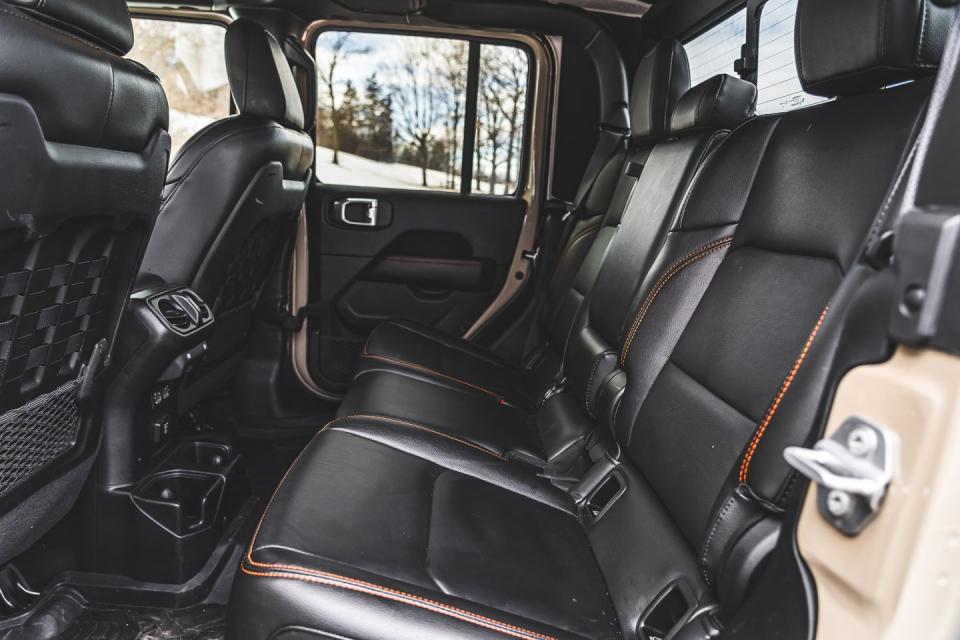
Owing in part to its stick axles, big all-terrain tires, and blocky profile, the Mojave also came under fire for its susceptibility to crosswinds, which magnifies its already pronounced tendency to wander between lane lines. Along with the cacophony of wind and road noise that permeates our Jeep's cabin at speed (with the hardtop installed), "The driving experience is pretty atrocious," observed director of vehicle testing Dave VanderWerp on an extended road trip with his family, noting that he was regularly holding 45 degrees of steering input to prevent the Gladiator from leaving its lane. Beard concurred. "Heavy-duty trucks track with more precision." He's also a bit salty about the meager 4500-pound tow rating of our manual-Mojave model. Indeed, that's down from the automatic version's 6000-pound maximum and less than many soft-roading crossovers can tug. "Pulling a two-place (3500-pound) snowmobile trailer can be done, but it's far from enjoyable," he added.
We're also not enjoying how frequently we have to fill the Mojave's 22.0-gallon fuel tank. Despite regular adventures around Michigan and long-haul voyages to Virginia and Tennessee, our truck continues to average just 15 mpg—the same figure that it returned on our 75-mph highway test, which is a pitiful 8 mpg less than its EPA estimate. "This is the rare gas-powered car that gets better fuel economy in stop-and-go city driving than on the highway," noted VanderWerp.
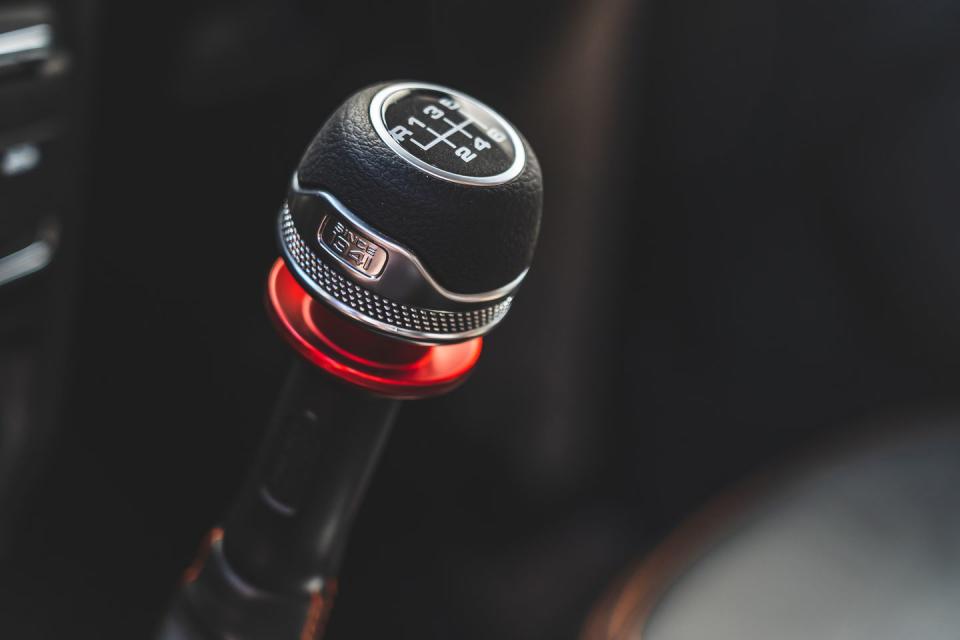
But with 27,000 miles still to go in our test, we're far from ready to admit we botched our truck's configuration. Jeep's Desert-rated Gladiator still rides impressively well considering its antiquated suspension, even our largest drivers have found comfort in the Mojave trim's supportive front seats, and this big-tired pickup remains effortlessly cool, as many head-swiveling passersby continue to confirm. We can chalk up some of the frustrations with our truck to its stay thus far coinciding with Michigan's dreary cold-weather months, which many of us endure in a state of semi-hibernation. Once we can romp through the sand dunes in the summer sun and cruise along the lakeside with the top and doors off, we'll hopefully be a little more forgiving of the Gladiator's shortcomings.
Months in Fleet: 7 months Current Mileage: 12,976 miles
Average Fuel Economy: 15 mpg
Fuel Tank Size 22.0 gal Observed Fuel Range: 330 miles
Service: $94 Normal Wear: $0 Repair: $0
Damage and Destruction: $0
Introduction
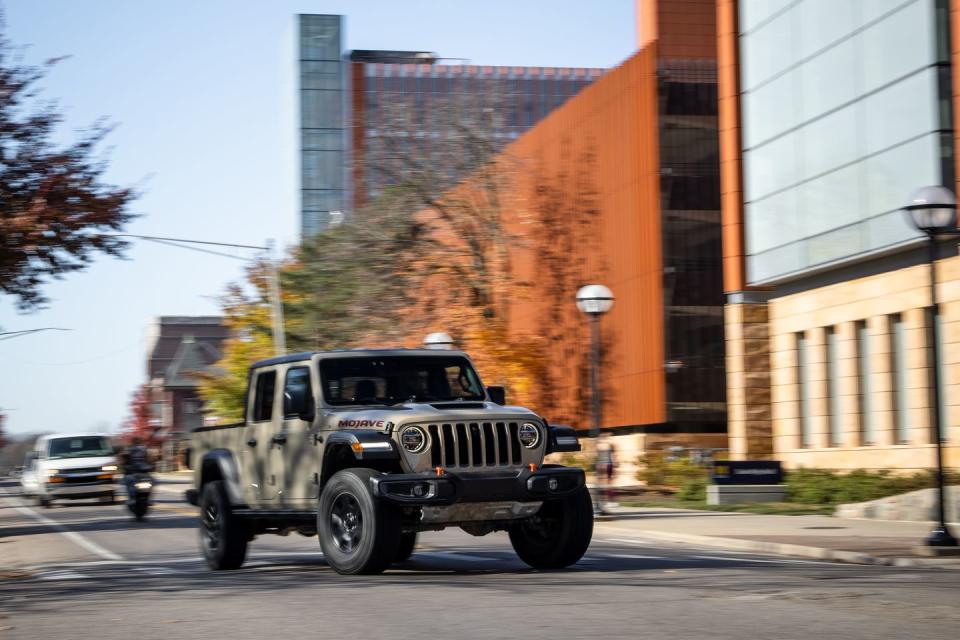
The unique physical makeup of the Jeep Gladiator gives it an undeniable cool factor. While four-door compact pickups are nothing new, there's only one that's based on the rolling anachronism that is the Jeep Wrangler, convertible top and all. The Gladiator even can be had with a feature that has almost completely disappeared from new pickups: a manual transmission. We immediately fell for its unusual charm and solid versatility, naming it to our 2020 10Best list upon its debut and largely agreeing it was the new small truck we'd want to own, despite a comparison test proving that it wasn't the best at its core mission.
It took a while to recruit a Gladiator for our long-term 40,000-mile test regimen, but that delay ultimately worked to our benefit. After the Gladiator's launch, a compelling new version was added to the lineup. Introduced earlier this year, the Mojave trim level sits alongside the burly Rubicon at the top of the Gladiator's model range and is the first of the Jeep brand's Desert Rated vehicles. Building on Jeep's familiar Trail Rated models that are fortified for conventional off-roading with stronger four-wheel-drive systems, skid plates, and upgraded tires, the Mojave is designed to excel in higher-speed off-road environments.

Along with a reinforced frame, 33-inch-tall tires on 17-inch wheels, and slight increases to the Gladiator's wheelbase and track, the Mojave gains new 2.5-inch Fox internal-bypass dampers, a 1.0-inch front suspension lift, and secondary Fox hydraulic front jounce dampers, which serve as additional heavy-duty, short-stroke shock absorbers that help prevent the suspension from bottoming out. While its Dana 44 axles are similar to the Rubicon's, the Mojave also features stronger front steering knuckles, a beefier rear axle housing, and a transfer case with a taller low-range ratio, 2.72:1 versus the Rubicon's 4.00:1. Model-specific front seats with additional side bolstering also are included.
Lacking the Rubicon's electronically locking front differential and disconnecting front anti-roll bar, the Mojave suffers a little when tackling mud holes and more technical off-road obstacles. But it does have a new Off Road Plus drive mode that dials back the traction control's intervention and sharpens the responses of the throttle and automatic transmission. For the 2021 model year, Off Road Plus also allows the Mojave's standard rear locking differential to be activated in 4HI mode. (The Rubicon's rear locker works only in 4LO.) Our truck does not have that ability at the moment, but Jeep says that it is working to make the feature a no-cost retrofit on 2020 models.
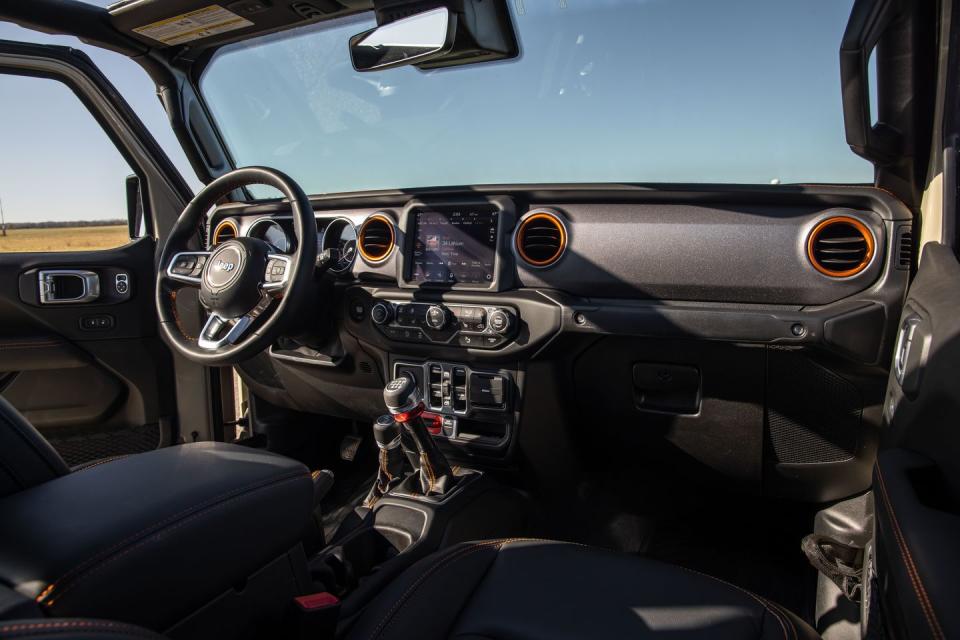
The 2020 Mojave carries the same $45,370 base price as the Rubicon. We opted for a rugged-looking coat of Gobi Clear Coat paint with black aluminum wheels and a black interior. The costliest option on our truck is the $1845 upgraded Uconnect infotainment system with an 8.4-inch touchscreen and an Alpine audio system. But we also splurged $1595 on leather upholstery, $1295 for a black three-piece removable hardtop, $1195 in LED exterior lights, and $1050 for protective rock-slider rails under the door sills.
Numerous smaller extras upped our truck's as-tested figure to $58,920, which is still less than pretty much every other Gladiator we've evaluated. Additional options include parking sensors and blind-spot monitoring ($895), a cargo management bundle with a bed-mounted power outlet and a lockable storage bin under the rear seat ($895), adaptive cruise control ($795), heaters for the steering wheel and front seats ($695), a roll-up tonneau cover ($595), a forward-facing trail camera ($595), a headliner for the hardtop ($555), keyless entry ($495), a spray-in bedliner ($495), a towing package and hitch ($350), all-weather floor mats ($165), and a tie-down strap for the fold-down windshield ($40).
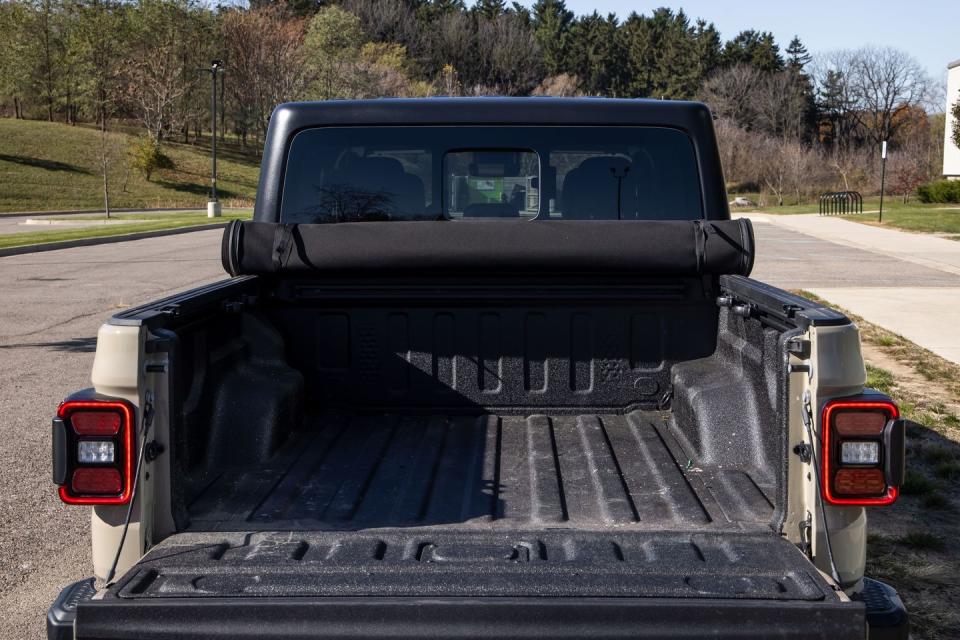
Our decision to pass on the Gladiator's newly optional EcoDiesel V-6 was easy because it's only available on 2021 Sport, Overland, and Rubicon models. Jeep deems the diesel's low-revving character to be less than ideal for the faster-paced action envisioned for the Mojave. What's more, the diesel can only be paired with the also-optional eight-speed automatic transmission. Notwithstanding the financial toll of that $6000 upgrade, there are those among us that believe on principle that hard-core Jeeps should only be fitted with stick shifts. For us, it was the Gladiator's standard 285-hp 3.6-liter gas V-6 and six-speed manual or nothing.
The big drawback of this configuration is that it reduces the truck's towing capacity. Whereas some models can tug up to 7650 pounds with the gas V-6, the Mojave's soft suspension limits it to 6000 pounds with the automatic. Opt for the manual, however, and that maximum falls to just 4500 pounds. Payload capacity is capped at 1200 pounds.
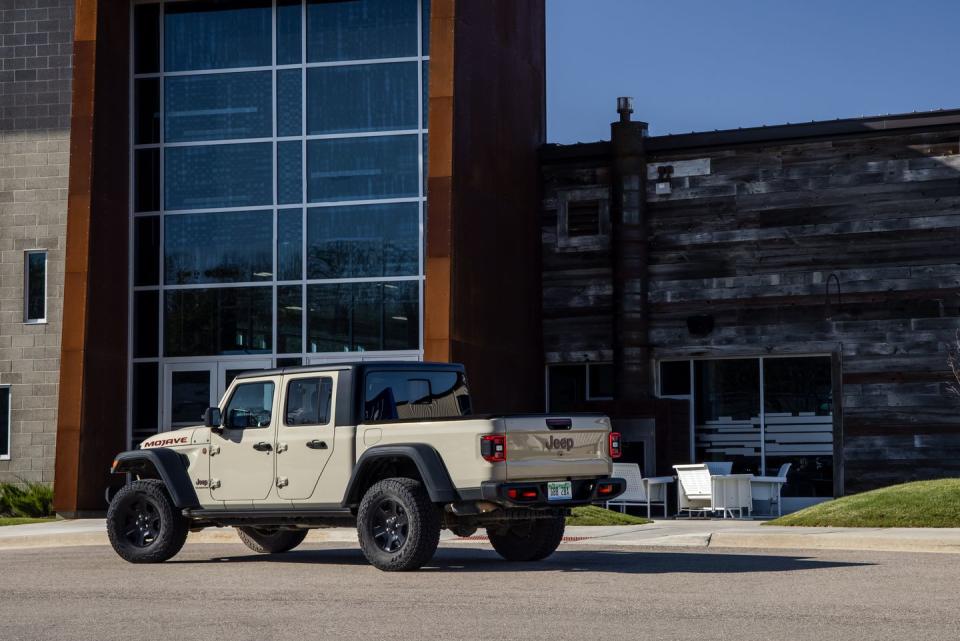
This is the first time we've had a Mojave at the test track—or, for that matter, a manual Gladiator of any type. But compared to the last Rubicon model equipped with the eight-speed automatic we evaluated, our 5175-pound long-termer weighs 83 fewer pounds. It takes a fair amount of work to reach the gas V-6's 4400-rpm torque peak, and the outright thrust it provides is merely adequate. Once our truck completed Jeep's short 300-mile break-in period, a brutal high-rpm clutch drop in 4HI launched it to 60 mph in a lazy 8.5 seconds—0.2 second slower than the Rubicon. Our truck trailed its sibling by the same amount (and 4 mph) through the quarter-mile, tripping the lights in 16.5 seconds at 82 mph. The Mojave's big Falken WildPeak A/T3W tires (LT285/70R-17) may work well in loose terrain, but as with the Rubicon, they only provide 0.72 g of grip on the skidpad. Stops from 70 mph take a long 197 feet.
Based on the action our Gladiator's already seen, its duty cycle will be an active one. Along with general commuting, it's towed a 3500-pound ski boat with no issue, visited our local off-road park, and traveled both north to Michigan's Upper Peninsula and south to Virginia International Raceway. Drivers seem to agree that the Mojave's softly sprung suspension and long wheelbase allow it to ride more comfortably than other new solid-axle Jeeps. Its steering is vague, its handling is clumsy, and the manual's long throws and numb clutch pedal are anything but precise. But we anticipated as much. More important, this is simply an enjoyable machine to operate. "Super fun," "an authentic Jeep experience," and "the best way to drive a Gladiator" all grace our truck's early logbook entries.
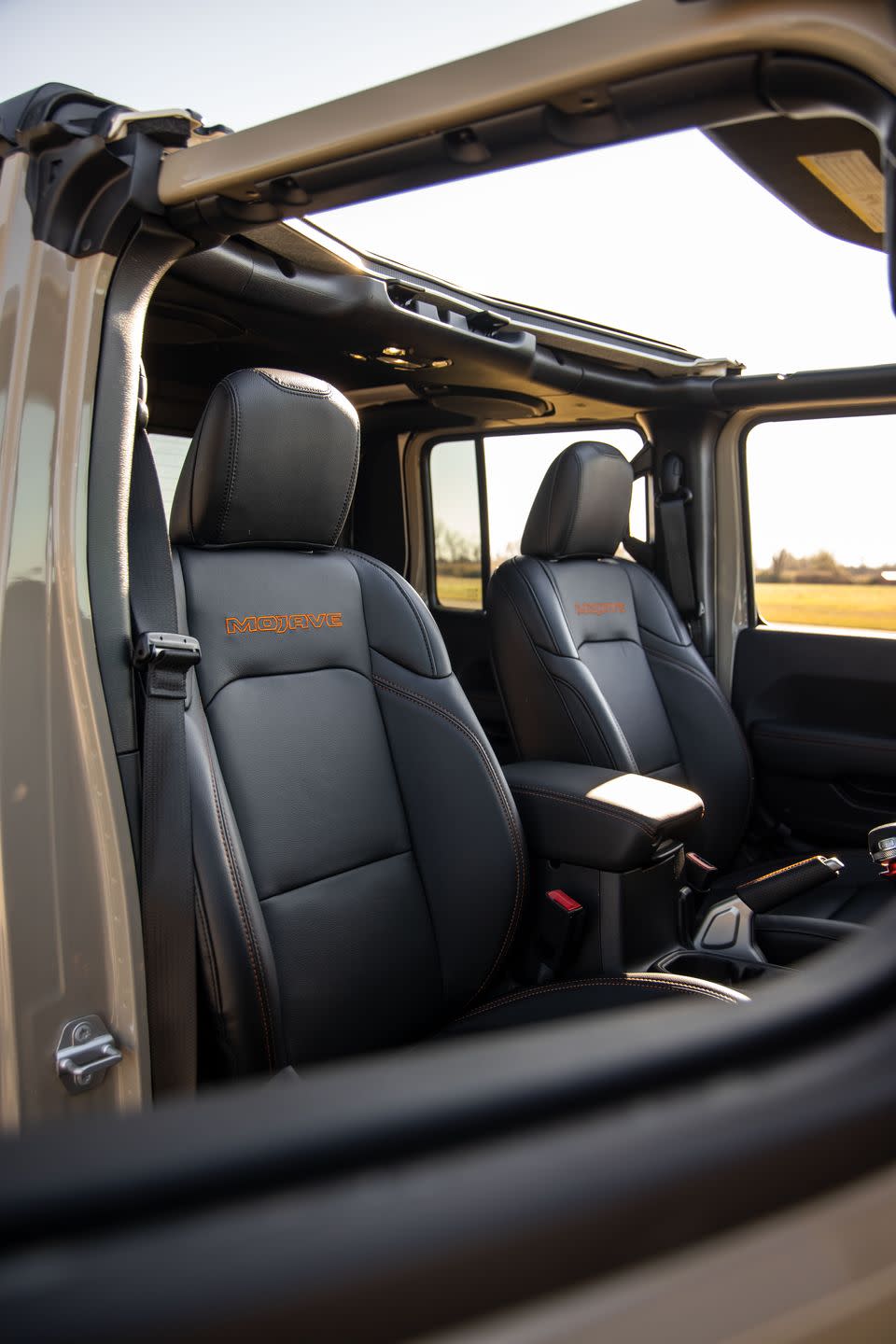
However, commenters have also noted plenty of shortcomings, including the Mojave's dismal 15-mpg average fuel economy. While some drivers find it quieter inside than they expected, our Gladiator's 71 decibels of interior noise at 70 mph is loud enough to impair the functionality of its voice recognition system. Its pedals also are spaced rather far apart for heel-and-toe work, and there's no dead pedal to rest your left foot. In back, the shallow cargo box is not tall enough with the tonneau cover installed to accommodate even a moderately sized cooler.
And all drivers agree that the Mojave is painfully slow, especially on the highway. "One-hundred-percent throttle is needed to merge, to climb, to pass, to get anywhere," wrote staff editor Austin Irwin. Testing deputy director K.C. Colwell echoed that sentiment on his trek to VIR, adding that downshifting to fourth gear for long stretches at a time was the only way to make meaningful progress in the Appalachians. On level ground and with the manual in sixth gear, the Mojave required a staggering 24.3 seconds to complete the 30-to-50-mph and 50-to-70-mph passing tests. With many adventures and more than 35,000 miles to go in our test, we'll have plenty of opportunities to see if the Mojave's unique charms can outweigh its negatives.
Months in Fleet: 2 months Current Mileage: 4556 miles
Average Fuel Economy: 15 mpg
Fuel Tank Size: 22.0 gal Observed Fuel Range: 330 miles
Service: $0 Normal Wear: $0 Repair: $0
Damage and Destruction: $0

You Might Also Like

 Yahoo Autos
Yahoo Autos 